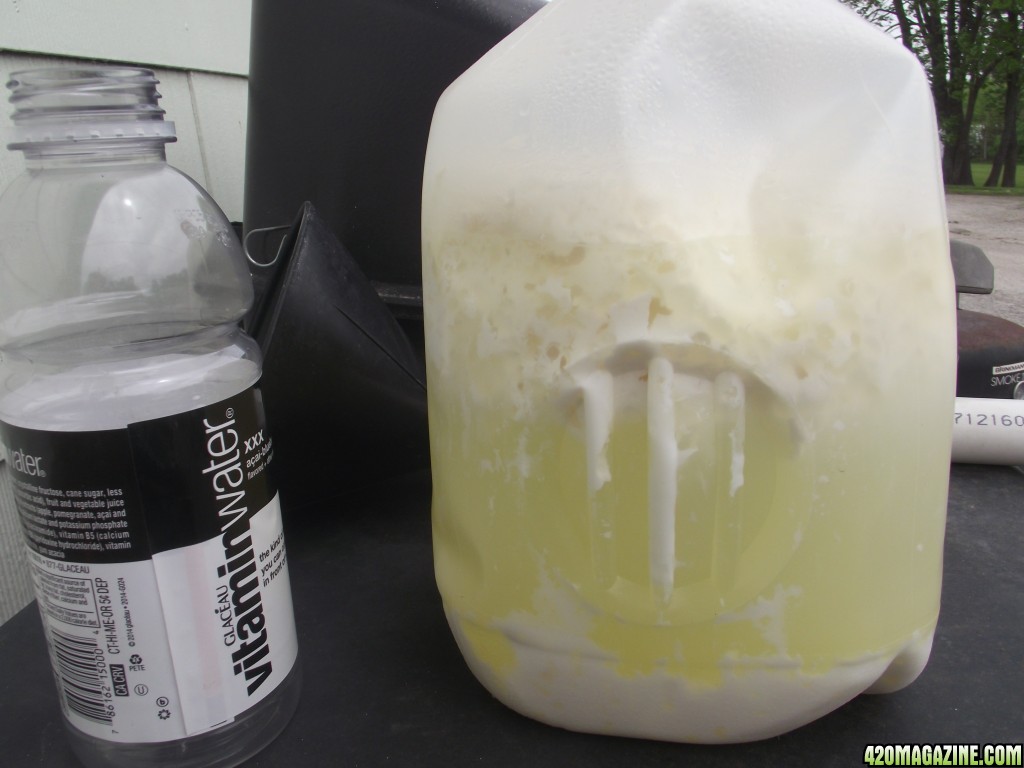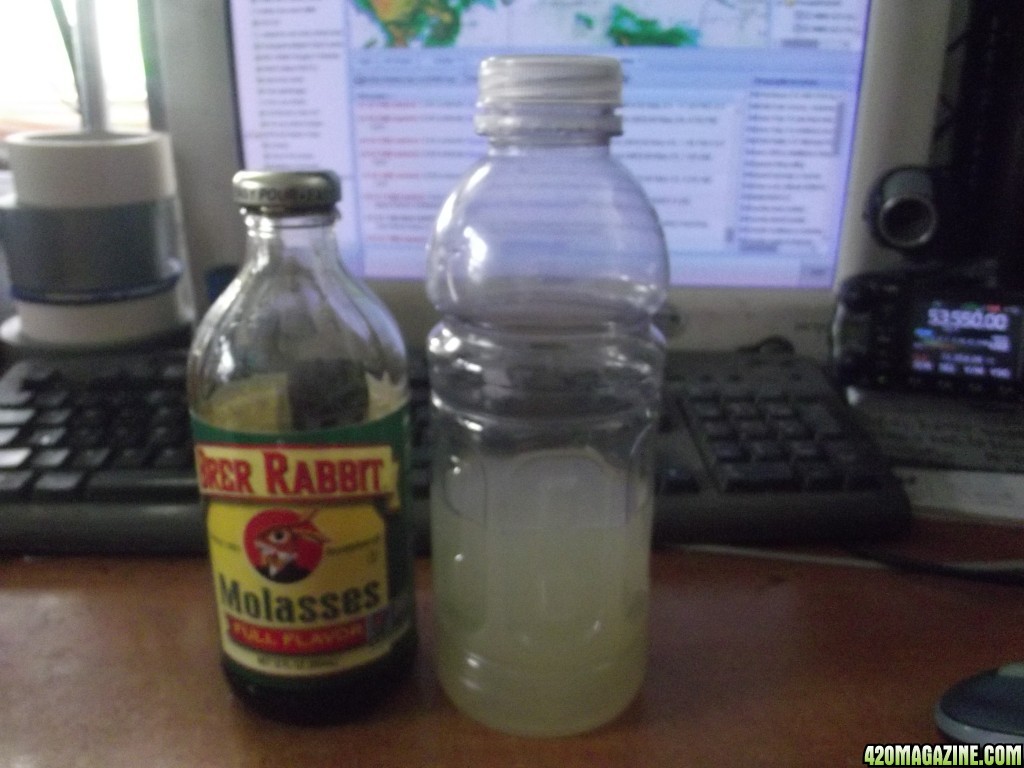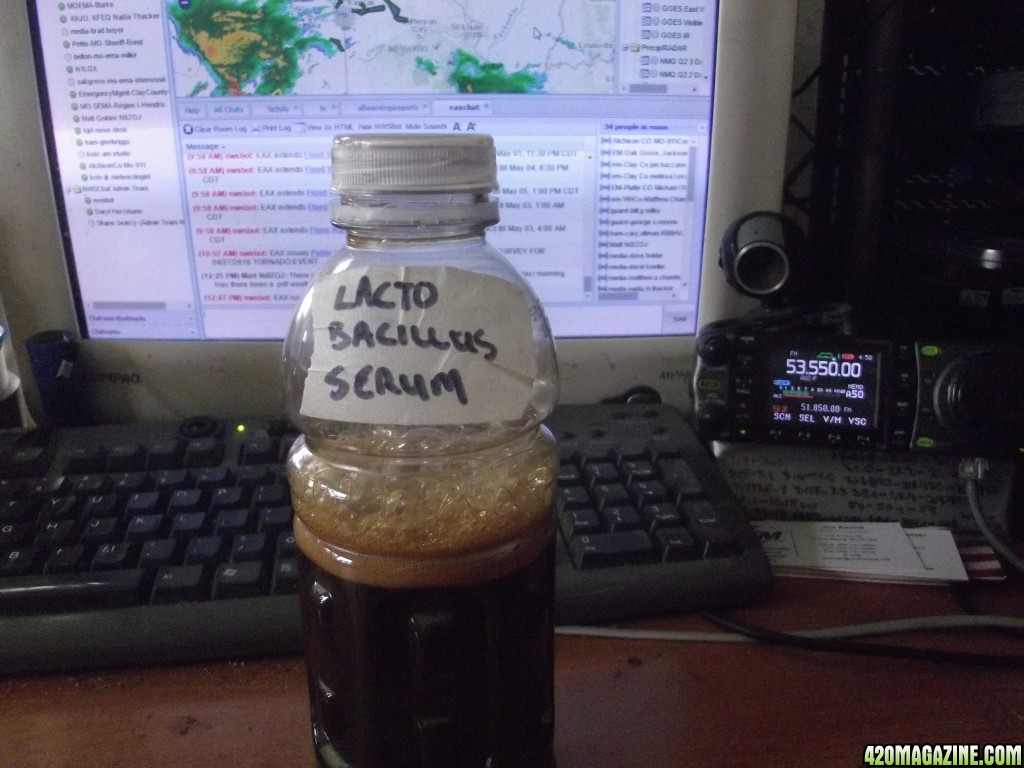Emilya;2883068 said:Today it is day 6 since putting the bacteria in the milk. I have not seen much change over the last 3 days or so, there is just about the same amount of yellow liquid as there was then. I think at this temperature and these conditions, this process was done in 3 days.

One change I will make next time is to use less of everything. The liquid produced from 1 quart of whole milk would have been sufficient for the vitamin water bottle amount of serum that I wanted to produce. After all, this stuff is going to be diluted 20:1 or more when it is used... If I had a farm, I would process a gallon of this stuff. My little bottle is going to last awhile in my tents.
So today we harvest our serum. It was poured through a screen (probably not necessary) and funneled into my water bottle to the point I marked because that corresponded to how much molasses I happened to have on hand today.

An equal amount of molasses was added to the bottle, and it was well shaken.
Presto... room temperature stable Lactobacillus Serum. If I felt I needed to store more of this, it can be stored in the fridge without the molasses.

What can we use Lactobacillus Serum for? I will be using it to break down organic materials for fertilizers, and it will be especially useful when making my homemade fish hydrolysate fertilizer.
Here are more uses for this stuff, copied from the web:
Lactobacillus bacteria used in Composting
One of the major workhorse beneficial indigenous micro-organism used in natural farming is lactobacillus. This particular beneficial microorganism is often used in composting for stopping foul odors associated with anaerobic decomposition. Lactic acid bacteria thrive and feed on the ammonia released in the decomposition normally associated with foul odors. So if you need to decompose or ferment wastes and stop foul odors, lactic acid bacteria is the specific bacteria to use. Its application in organic farming is enormous.
Lactobacillus used in Aquaculture
In aquaculture, one of the problem is related to water quality. Poor water quality stresses the fish which in turn stunts their growth and affects their health. This is very evident especially in high density and tank aquaculture. The ammonia produced through fish excretions pollute the water and stress the fish. Regular addition of lactobacillus beneficial microorganisms to the water, minimizes the ammonia problem, if not stopping it completely. It helps hasten or complete the denitrification by converting wastes into forms not harmful to fish.
Spraying a diluted solution of lactic acid bacteria serum on to the plant and soil helps plant growth and health. As it is applied to the soil or the leaves, these beneficial bacteria aid in the decomposition process, thus allowing more food to be available and assimilated by the plant.
Lactic acid bacteria is also known to produce enzymes and natural antibiotics aiding effective digestion and has antibacterial properties, including control of salmonella and e. coli. Farmers see an improvement in the general health of the plants and animals, better nutrient assimilation, feed conversion and certain toxins eliminations.
Navigation
Install the app
How to install the app on iOS
How To Use Progressive Web App aka PWA On 420 Magazine Forum
Note: This feature may not be available in some browsers.
More options
You are using an out of date browser. It may not display this or other websites correctly.
You should upgrade or use an alternative browser.
You should upgrade or use an alternative browser.
Making your own Lactobacillus Serum #3
- Author key1999
- Create date
Blog entry information
More entries in Member Blogs
-
Is Cannabis Market Transforming into a Fast-Moving Consumer Goods (FMCG) Sector?Traditionally, the global cannabis consumption market was viewed mainly as a raw material...
-
The Rise of Skate Vape: A New Design Trend in Cannabis ConsumptionAs the cannabis vaping market continues to evolve, new product trends are emerging that push the...
-
Why the Vape with Screen is Gaining Popularity in Cannabis?The cannabis vaporizer industry is evolving rapidly, and one trend that has gained significant...
-
How to Choose the Right Cannabis Vape with A Screen for YouAs the cannabis industry rapidly evolves, the competition among suppliers has intensified...
-
Why Are More Cannabis Brands Introducing Vapes with Screen Display?As the cannabis industry rapidly evolves, the competition among suppliers has intensified...


